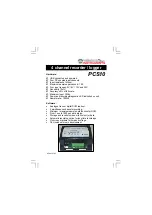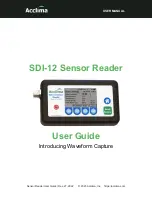
15.2
GEN series voltage probe types
HBM offers a variety of probes. Which probe is needed depends on the
application and which instrument is being used. It is important to match the
compensation of the probe to the instrument.
l
Passive, single
-
ended voltage probes
These probes can be used with single
-
ended or differential non
-
isolated
amplifiers and increase the input range of the amplifier only in single
-
ended
mode. They typically decrease the overall accuracy of the amplifier.
l
Passive, single
-
ended isolated voltage probes
These probes can be used with single
-
ended or differential isolated
amplifiers and increase the input range of an isolated amplifier only in
single
-
ended mode. They typically decrease the overall accuracy of the
amplifier.
It is important to understand that they increase only the range, not the
isolation voltage.
l
High accuracy passive, single
-
ended isolated voltage probes
These probes are designed to match specific single
-
ended amplifiers and
increase the input range of an isolated unbalanced amplifier while
maintaining accuracy.
It is important to understand that they increase only the range, not the
isolation voltage.
l
Passive, differential matched isolated voltage probes
These probes can be used with differential isolated amplifiers and increase
the input range of the amplifier in differential mode. They typically decrease
the overall accuracy and the CMRR of the amplifier.
They work with isolated and non
-
isolated variations of differential
amplifiers.
When used with isolated amplifiers, they increase only the range, not the
isolation voltage.
l
Active differential voltage probes
These probes are self
-
contained, differential amplifiers to be used in front
of an instrument using any amplifier in single
-
ended mode.
The input range and accuracy depend on the type of active differential
probe used and have no relation to the amplifier used. They usually operate
from batteries; this causes some inconvenience.
l
Current clamps
Current clamps function more as transducers than probes, as they convert
one physical quantity (current) into another one (usually voltage). They are
used to perform non
-
invasive current measurements. This allows the
current in a circuit to be measured without disturbing the circuit.
Note
There are other possibilities to measure current as well (current shunts, or
Rogowski coils).
GEN3i
346
I3763-3.1 en HBM: public
















































